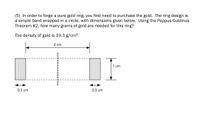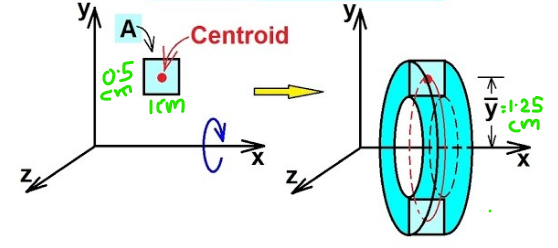
Elements Of Electromagnetics
7th Edition
ISBN: 9780190698614
Author: Sadiku, Matthew N. O.
Publisher: Oxford University Press
expand_more
expand_more
format_list_bulleted
Concept explainers
Question

Transcribed Image Text:**Text and Diagram Transcription for Educational Use**
**Problem:**
To forge a pure gold ring, you first need to determine the amount of gold required. The ring is designed as a simple band formed into a circle. The dimensions provided are essential to calculate the mass of gold needed using the Pappus-Guldinus Theorem #2.
- **Density of Gold:** 19.3 g/cm³
**Diagram Details:**
The diagram represents a rectangular strip that will be shaped into a ring.
- **Dimensions:**
- Length of the strip: 2 cm
- Width of the strip: 1 cm
- Thickness of the strip: 0.5 cm
The strip will be wrapped to form a circular band. The Pappus-Guldinus Theorem #2 can be applied to determine the volume of the resulting solid of revolution, which in turn can be used to find the mass of the gold ring.
**Objective:**
Calculate the mass of the gold required to create the ring using the provided dimensions and the density of gold.
---
This transcription helps to visualize and understand the problem, making it suitable for educational purposes on a website.

Transcribed Image Text:If the price of gold is $60/g, how much will the gold for the ring cost?
(Note: The image does not provide additional details or a graph to explain. The cost will depend on the weight of the gold in the ring, which is not specified in the text.)
Expert Solution
arrow_forward
Step 1

According to Pappus–Guldinus theorem
volume can be given as
Step by stepSolved in 2 steps with 1 images

Knowledge Booster
Learn more about
Need a deep-dive on the concept behind this application? Look no further. Learn more about this topic, mechanical-engineering and related others by exploring similar questions and additional content below.Similar questions
- Kayleigh loves fishing with her grandpa Kevin. Kayleigh was the first one to catch a fish and found out that it weighs 90 Newtons out of the river. When the fish was completely immersed in the river water, the tension of the fishing rod line was 55 N. Her grandpa Kevin proceeded to fish in the muddy part of the river and caught an almost identically sized fish. Kevin measured the tension of his rod line to be 30 N. What is the density of the water in the muddy part of the river? Remember that the density of water is 997 kg/m³arrow_forwardCalculate for the self-weight of a floor finish, in Pa, for the second floor of an office building using a 20.3" square Carpet Tile. One box weighs 47 lbs and contains 24 tiles. Use the direct conversion factor for psi to Pa provided in the Math- Mechanics Common Formula Sheet. Show complete work. It is optional to provide diagrams. a. Self-weight in psi is (4 decimal places) b. Self-weight in Pa is (2 decimal places)arrow_forwardfind the answer If 5 kg of water in a 0.4 m^3 container is heated to 525°C, what pressure is developed in bars? Hint: Use the steam table. Write the answer up to TVO DECIMAL PLACES. Your answerarrow_forward
- Find out the silk density in g/cc if the specific gravity of the fiber is given as 1.32. Provide your answer with two decimal positions and no unit. Answer:arrow_forwardAn electric hot water heater consumes 3.1 kilowatts of electricity and converts it to heat. How long will it take the water heater to heat a 67 gallon tank of water from 10 degrees Celsius to 50 degrees Celsius? (1 kilogram of water is 0.37 gallons, 1 Calorie = 4200 J). It may be helpful to refer back to the weekly handout for guidance on this problem. Your final answer should be in minutes (rounded to the nearest 10 minutes).arrow_forwardThe figure shows a wooden model to reproduce a metal piece ofaluminum through the sand casting process.a) How much mass (g or kg) of aluminum do you need to melt?b) How much energy Q (Joules) is required? Assume an initial temperature of 50 ° C and a100% thermal efficiency.c) What dimensions will the final metal piece have? all is in cmarrow_forward
- ⦁ A hot air balloon holds 7.40 x 107 liters of gas. In order for the hot air balloon to rise into the sky, it must be heated to 120°C. Once the balloon is up in the air, the air needs to be cooled in order for the balloon to land. If the temperature of the balloon is decreased to 40.0°C, what will the new volume of the gas be? Remember to pay close attention to the units of temperature before beginning your calculations.arrow_forwardCalculate the volume of pacific ocean (in mm3) in a micro-scale earth built at a one billionth scale. Assume the radius of the small scale earth is 5.3 mm, and the pacific ocean area is 24 % of the global surface and the average depth of the ocean is 3.79 mm.arrow_forwardCalculate, in degrees Rankine, the temperature interval of 73.6°C. Use two decimal places in your answerarrow_forward
- Please don't Copy, Solve via Handwritten Only.arrow_forwardPlease don't provide handwritten solution.arrow_forward10.Compute the pressure difference between 'm' and 'n' as shown by the differential manometer in KPa water plpeline +. where: a= 12" b= 3.2' C= 4.0' d- 12" mercury density (16 300 kg/m³) water pipelinearrow_forward
arrow_back_ios
SEE MORE QUESTIONS
arrow_forward_ios
Recommended textbooks for you
 Elements Of ElectromagneticsMechanical EngineeringISBN:9780190698614Author:Sadiku, Matthew N. O.Publisher:Oxford University Press
Elements Of ElectromagneticsMechanical EngineeringISBN:9780190698614Author:Sadiku, Matthew N. O.Publisher:Oxford University Press Mechanics of Materials (10th Edition)Mechanical EngineeringISBN:9780134319650Author:Russell C. HibbelerPublisher:PEARSON
Mechanics of Materials (10th Edition)Mechanical EngineeringISBN:9780134319650Author:Russell C. HibbelerPublisher:PEARSON Thermodynamics: An Engineering ApproachMechanical EngineeringISBN:9781259822674Author:Yunus A. Cengel Dr., Michael A. BolesPublisher:McGraw-Hill Education
Thermodynamics: An Engineering ApproachMechanical EngineeringISBN:9781259822674Author:Yunus A. Cengel Dr., Michael A. BolesPublisher:McGraw-Hill Education Control Systems EngineeringMechanical EngineeringISBN:9781118170519Author:Norman S. NisePublisher:WILEY
Control Systems EngineeringMechanical EngineeringISBN:9781118170519Author:Norman S. NisePublisher:WILEY Mechanics of Materials (MindTap Course List)Mechanical EngineeringISBN:9781337093347Author:Barry J. Goodno, James M. GerePublisher:Cengage Learning
Mechanics of Materials (MindTap Course List)Mechanical EngineeringISBN:9781337093347Author:Barry J. Goodno, James M. GerePublisher:Cengage Learning Engineering Mechanics: StaticsMechanical EngineeringISBN:9781118807330Author:James L. Meriam, L. G. Kraige, J. N. BoltonPublisher:WILEY
Engineering Mechanics: StaticsMechanical EngineeringISBN:9781118807330Author:James L. Meriam, L. G. Kraige, J. N. BoltonPublisher:WILEY

Elements Of Electromagnetics
Mechanical Engineering
ISBN:9780190698614
Author:Sadiku, Matthew N. O.
Publisher:Oxford University Press

Mechanics of Materials (10th Edition)
Mechanical Engineering
ISBN:9780134319650
Author:Russell C. Hibbeler
Publisher:PEARSON

Thermodynamics: An Engineering Approach
Mechanical Engineering
ISBN:9781259822674
Author:Yunus A. Cengel Dr., Michael A. Boles
Publisher:McGraw-Hill Education

Control Systems Engineering
Mechanical Engineering
ISBN:9781118170519
Author:Norman S. Nise
Publisher:WILEY

Mechanics of Materials (MindTap Course List)
Mechanical Engineering
ISBN:9781337093347
Author:Barry J. Goodno, James M. Gere
Publisher:Cengage Learning

Engineering Mechanics: Statics
Mechanical Engineering
ISBN:9781118807330
Author:James L. Meriam, L. G. Kraige, J. N. Bolton
Publisher:WILEY